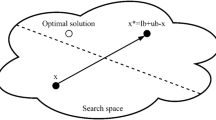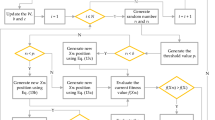Abstract
The structure of artificial neural networks and the biological nervous systems serve as the foundation for the creation of the neural network algorithm (NNA). The robust global search capability of NNAs makes it an effective tool for solving a wide range of complex optimization problems. Unfortunately, its limited relevance to many optimization problems is due to its poor exploitation, weak convergence, and tendency to fall into local optima. The paper’s goal is to introduce an enhanced version of the NNA known as the adaptive quasi-opposition-based neural network algorithm (AQOBNNA) in order to overcome these issues. The quasi-opposition-based learning (QOBL) and an adaptive strategy are combined in this suggested algorithm, where the adaptive technique is added to determine whether or not to use QOBL. The QOBL technique replaces a random search individual with the best one throughout the position update phase in order to enhance exploitation and increase exploration capabilities. The performance of the suggested AQOBNNA is assessed using a set of 23 traditional benchmark functions and compared with a number of current methods. It is evident from the experimental data that AQOBNNA performs better overall and outperforms all the algorithms that were examined.












Similar content being viewed by others
Explore related subjects
Discover the latest articles and news from researchers in related subjects, suggested using machine learning.Data Availability
No data were used to support the study.
References
Abd Elaziz M, Oliva D, Xiong S. An improved opposition-based sine cosine algorithm for global optimization. Expert Syst Appl. 2017;90:484–500.
Arora S, Singh S. Butterfly optimization algorithm: a novel approach for global optimization. Soft Comput. 2019;23:715–34.
Ayad J. Survey on neural networks in networking: Applications and advancements. Babylonian Journal of Networking. 2024;2024:135–47.
Balasubramani K, Natarajan UM. Improving bus passenger flow prediction using Bi-LSTM fusion model and SMO algorithm. Babylonian Journal of Artificial Intelligence. 2024;2024:73–82.
Braik M, Hammouri A, Atwan J, Al-Betar MA, Awadallah MA. White Shark Optimizer: A novel bio-inspired meta-heuristic algorithm for global optimization problems. Knowl-Based Syst. 2022;243: 108457.
Chandran V, Mohapatra P. An improved tunicate swarm algorithm with random opposition based learning for global optimization problems. Opsearch. 2024;1–26.https://doi.org/10.1007/s12597-024-00828-3
Chopra N, Ansari MM. Golden jackal optimization: A novel nature-inspired optimizer for engineering applications. Expert Syst Appl. 2022;198: 116924.
Civicioglu P, Besdok E. Colony based search algorithm for numerical optimization. Appl Soft Comput. 2024;151: 111162.
Deb K. Optimal design of a welded beam via genetic algorithms. AIAA J. 1991;29(11):2013–5.
Derrac J, Garca S, Molina D, Herrera F. A practical tutorial on the use of nonparametric statistical tests as a methodology for comparing evolutionary and swarm intelligence algorithms. Swarm Evol Comput. 2011;1(1):3–18.
Dorigo M, Birattari M, Stutzle T. Ant colony optimization. IEEE Comput Intell Mag. 2006;1(4):28–39.
Eskandar H, Sadollah A, Bahreininejad A, Hamdi M. Water cycle algorithm-A novel metaheuristic optimization method for solving constrained engineering optimization problems. Computers & Structures. 2012;110:151–66.
Ewees AA, Abd Elaziz M, Houssein EH. Improved grasshopper optimization algorithm using opposition-based learning. Expert Syst Appl. 2018;112:156–72.
Faramarzi A, Heidarinejad M, Mirjalili S, Gandomi AH. Marine Predators Algorithm: A nature-inspired metaheuristic. Expert Syst Appl. 2020;152: 113377.
Gupta S, Deep K. A hybrid self-adaptive sine cosine algorithm with opposition based learning. Expert Syst Appl. 2019;119:210–30.
Gupta S, Deep K. An efficient grey wolf optimizer with opposition-based learning and chaotic local search for integer and mixed-integer optimization problems. Arab J Sci Eng. 2019;44(8):7277–96.
Heidari AA, Mirjalili S, Faris H, Aljarah I, Mafarja M, Chen H. Harris hawks optimization: Algorithm and applications. Futur Gener Comput Syst. 2019;97:849–72.
Haeri Boroujeni SP, Pashaei E. A hybird chimp optimization algorithm and generalized normal distribution algorithm with opposition based learninig strategy for solving data clustering problems. Iran Journal of Computer Science. 2024;7(1):65–101.
Ibrahim RA, Abd Elaziz M, Lu S. Chaotic opposition-based grey-wolf optimization algorithm based on differential evolution and disruption operator for global optimization. Expert Syst Appl. 2018;108:1–27.
Karaboga D, Basturk B. On the performance of artificial bee colony (ABC) algorithm. Applied Soft Computing Journal. 2008;8(1):687–97.
Kennedy J, Eberhart R. Particle swarm optimization. Proceedings of ICNN’95 - International Conference on Neural Networks. 1995;4:1942–1948.
Kirkpatrick S, Gelatt CD Jr, Vecchi MP. Optimization by simulated annealing science. 1983;220(4598):671–80.
Kouidere A, Damak M. Using neural networks to model complex mathematical functions. Mesopotamian Journal of Big Data. 2022;2022:51–4. https://doi.org/10.58496/MJBD/2022/007
Kouka N, BenSaid F, Fdhila R, Fourati R, Hussain A, Alimi AM. A novel approach of many-objective particle swarm optimization with cooperative agents based on an inverted generational distance indicator. Inf Sci. 2023;623:220–41.
Kundu T, Deepmala, Jain PK. A hybrid salp swarm algorithm based on TLBO for reliability redundancy allocation problems. Appl Intell. 2022;52:12630–67.
Lei D, Cai L, Wu F. Imperialist competition algorithm with quasi-opposition based learniing for function optimization and engineering design problems. Automatika. 2024;65(4):1640–65.
Li S, Chen H, Wang M, Heidari AA, Mirjalili S. Slime mould algorithm: A new method for stochastic optimization. Futur Gener Comput Syst. 2020;111:300–23.
Luo R, Peng Z, Hu J, Ghosh BK. Adaptive optimal control of affine nonlinear systems via identifier-critic neural network approximation with relaxed PE conditions. Neural Netw. 2023;167:588–600.
Mirjalili S. Dragonfly algorithm: a new meta-heuristic optimization technique for solving single-objective, discrete, and multi-objective problems. Neural Comput Appl. 2016;27(4):1053–73.
Mirjalili S, Lewis A. The Whale Optimization Algorithm. Adv Eng Softw. 2016;95:51–67.
Mirjalili S, Mirjalili SM, Lewis A. Grey Wolf Optimizer. Adv Eng Softw. 2014;69:46–61.
Mirjalili S. Moth-flame optimization algorithm: A novel nature-inspired heuristic paradigm. Knowl-Based Syst. 2015;89:228–49.
Mirjalili S, Gandomi AH, Mirjalili SZ, Saremi S, Faris H, Mirjalili SM. Salp Swarm Algorithm: A bio-inspired optimizer for engineering design problems. Adv Eng Softw. 2017;114:163–91.
Mirjalili S. SCA: A Sine Cosine Algorithm for solving optimization problems. Knowl-Based Syst. 2016;96:120–33.
Mohamed AW. A novel differential evolution algorithm for solving constrained engineering optimization problems. J Intell Manuf. 2018;29(3):659–92.
Qamar R, Zardari BA. Artificial neural networks: An overview. Mesopotamian Journal of Computer Science. 2023;2023:124–33.
Rahnamayan S, Tizhoosh HR, Salama MM. Quasi-oppositional differential evolution. In: 2007 IEEE congress on evolutionary computation. 2007. (pp. 2229–2236). IEEE.
Rao RV, Savsani VJ, Vakharia DP. Teaching-learning-based optimization: A novel method for constrained mechanical design optimization problems. CAD Computer Aided Design. 2011;43(3):303–15.
Rashedi E, Nezamabadi-Pour H, Saryazdi S. GSA: a gravitational search algorithm. Inf Sci. 2009;179(13):2232–48.
Sadollah A, Sayyaadi H, Yadav A. A dynamic metaheuristic optimization model inspired by biological nervous systems: Neural Network Algorithm. Applied Soft Computing Journal. 2018;71:747–82.
Savsani P, Savsani V. Passing vehicle search (PVS): A novel metaheuristic algorithm. Appl Math Model. 2016;40(5–6):3951–78.
Simon D. Biogeography-Based Optimization. IEEE Trans Evol Comput. 2008;12(6):702–13.
Tizhoosh HR. Opposition-based learning: a new scheme for machine intelligence. In: International conference on computational intelligence for modelling, control and automation and international conference on intelligent agents, web technologies and internet commerce (CIMCA-IAWTIC’06). 2005. (Vol. 1, pp. 695–701). IEEE.
Truong KH, Nallagownden P, Baharudin Z, Vo DN. A quasi-oppositional-chaotic symbiotic organisms search algorithm for global optimization problems. Appl Soft Comput. 2019;77:567–83.
Wolpert DH, Macready WG. No free lunch theorems for optimization. IEEE Trans Evol Comput. 1997;1(1):67–82.
Xu X, Lin Z, Li X, Shang C, Shen Q. Multi-objective robust optimisation model for MDVRPLS in refined oil distribution. Int J Prod Res. 2022;60(22):6772–92.
Xu Y, Chen H, Heidari AA, Luo J, Zhang Q, Zhao X, Li C. An efficient chaotic mutative moth-flame-inspired optimizer for global optimization tasks. Expert Syst Appl. 2019;129:135–55.
Yang XS, Deb S. Cuckoo search via Lévy flights. 2009 World Congress on Nature and Biologically Inspired Computing, NABIC 2009 - Proceedings. 2009. 210–214.
Yang XS, Gandomi AH. BAT algorithm: a novel approach for global engineering optimization. Eng Comput. 2012;29:464–83.
Yang XS. Flower pollination algorithm for global optimization. International Conference on Unconventional Computing and Natural Computation. 2012. (pp. 240-249). Springer, Berlin, Heidelberg.
Yang J, Yang F, Zhou Y, Wang D, Li R, Wang G, Chen W. A data-driven structural damage detection framework based on parallel convolutional neural network and bidirectional gated recurrent unit. Inf Sci. 2021;566:103–17.
Zhang Y, Jin Z, Chen Y. Hybrid teaching-learning-based optimization and Neural Network Algorithm for engineering design optimization problems. Knowl-Based Syst. 2020;187: 104836.
Zhang Y, Jin Z, Chen Y. Hybridizing grey wolf optimization with Neural Network Algorithm for global numerical optimization problems. Neural Comput Appl. 2020;32(14):10451–70.
Zhang M, Wen G. Duck swarm algorithm: theory, numerical optimization, and applications. Clust Comput. 2024;27:6441–69.
Author information
Authors and Affiliations
Corresponding author
Ethics declarations
Ethical Approval
This article does not contain any studies with human participants or animals performed by any of the authors.
Conflict of Interest
The authors declare no competing interests.
Additional information
Publisher's Note
Springer Nature remains neutral with regard to jurisdictional claims in published maps and institutional affiliations.
Rights and permissions
Springer Nature or its licensor (e.g. a society or other partner) holds exclusive rights to this article under a publishing agreement with the author(s) or other rightsholder(s); author self-archiving of the accepted manuscript version of this article is solely governed by the terms of such publishing agreement and applicable law.
About this article
Cite this article
Kundu, T., Garg, H. An Adaptive Neural Network Algorithm with Quasi Opposition-Based Learning for Numerical Optimization Problems. Cogn Comput 17, 55 (2025). https://doi.org/10.1007/s12559-025-10415-3
Received:
Accepted:
Published:
DOI: https://doi.org/10.1007/s12559-025-10415-3




